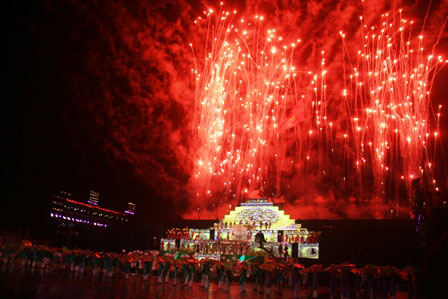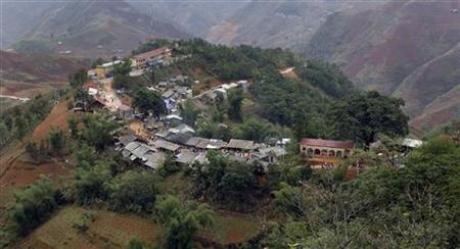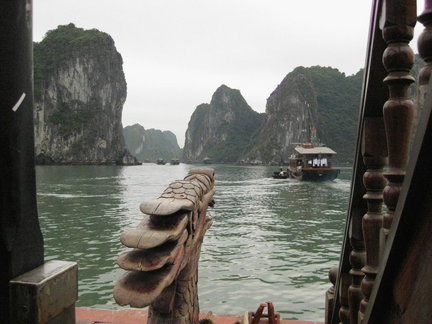As Hanoi celebrates its 1,000th birthday, Clifford Coonan visits a city that offers an appealing mixture of gritty Vietnamese street life and relaxed post-colonial ease.
 Turning a corner in Hanoi, you come across a crowd of lively old men sitting outside the cafe, a small basket of brioches and a plate of stringy cheese in front of them as they discuss the latest developments in the capital over cafés au lait , their conversation punctuated by the parps and beeps of cyclos – or cycle rickshaws – and Hondas zipping by.
Turning a corner in Hanoi, you come across a crowd of lively old men sitting outside the cafe, a small basket of brioches and a plate of stringy cheese in front of them as they discuss the latest developments in the capital over cafés au lait , their conversation punctuated by the parps and beeps of cyclos – or cycle rickshaws – and Hondas zipping by.
You have to check your watch to make sure you’re in the right time zone, the right continent or even the right point in history. The coffee they drink is Vietnamese – brewed French style, of course – but the jackfruit and mango they chew on set this scene apart from anything you will see in France. This is definitely Asia.
It’s an arresting moment, typical in the Vietnamese capital, which is celebrating its 1,000th birthday this year and manages to retain its old-style appeal despite the passing years and the pressure to modernise.
It has all the dirt and traffic of a developing world city but combines bustle and calm in a way similar to that of a working French town in a wine region. Hanoi offers an appealing combination of gritty Vietnamese street life and relaxed postcolonial ease.
Sitting on the veranda outside the Metropole hotel, one of Asia’s most famous addresses, you can check out a vintage Citroën from the 1930s and a rickshaw. Four years of renovation of this hotel, now operated by Sofitel, have sharpened its appeal but left its heritage intact. For a few delicious seconds you can imagine Graham Greene witnessing a continent in transformation, soon to re-create this vision in an enduring work of art like The Quiet American .
The writer stayed at the Metropole – which occupies the same space in the city’s mental landscape that the Shelbourne Hotel does in Dublin – Charlie Chaplin had his honeymoon here, and more recent arrivals include Robert McNamara, John F Kennedy’s secretary of defence and the architect of the Vietnam War, whose relentless bombing campaigns brought sorrow, and a steely resolve, to the hearts of the citizens of what was then the North Vietnamese capital. Many of the legendary Vietnam War correspondents filed their stories from here.
For the first eight centuries of its existence Hanoi was a Chinese city, and you can still sense the Chinese business ethic in the way people hustle here. This is also evident in its focus on education – the first Vietnamese universities were founded here.
Originally called Thang Long, it was renamed Hanoi in 1831, and after it became a French protectorate, in the 1880s, Hanoi was transformed into a French city, capital of the French Indo-Chinese empire. Army officers from Paris left an enduring bootprint in the solid, elegant edifices and sweeping boulevards that make Hanoi a refuge for those seeking a sense of Montpellier and Lyons to match the fascination of southeast Asia.
There are lots of ways to get around Hanoi, and motorbike drivers offering you a route through the city’s sclerotic traffic channels regularly approach you. Many are simply keen to practise their English and are not on the make, but it’s sometimes hard to tell when you are being hustled.
At an intersection near the Hoan Kiem Lake, in the Old Quarter, the sound of motorbikes idling is like the anticipatory moments before a Grand Prix. Tensions are high, and a motorbike bumps into a scooter, toppling a row of five bikes. There are no outraged recriminations, however, or even an exchange of telephone numbers. A young woman on the pillion of the aggrieved party’s scooter is concerned about her heels, but that’s about the extent of it. Road rage is not a big thing in Vietnam.
Taxis and cyclos abound, but to get a sense of Vietnam’s capital and second-largest city it’s probably best to walk. This is not always easy to do, as this is still very much a city in the developing world, and pavements tend to trail off into gutters or, increasingly, building sites.
Along the roads of the Old Quarter, bars selling bia hoi – or light, fresh beer – jostle with new art galleries for space, each building’s address marked out on small plates with white numbers on a background left by the French.
Here you can find pretty much anything you would ever need, from knock-off luggage to high-end designer clobber. The Hanoi Gallery offers reprints of stirring, beautifully worked propaganda posters, which help tourists understand how Vietnam, despite its southeast Asian tranquillity and poise, is underpinned by a toughness that has never been tamed, despite military efforts by France, Australia, the US and China in living memory.
You will still hear bitterness about the decision of Richard Nixon’s government to give the go-ahead to the “Christmas bombing” of Hanoi. From December 18th to 30th, 1972, waves of American B-52s dropped 40,000 tons of bombs on the mostly evacuated city. Although Washington DC said it had to be done, the world’s reaction did a lot to turn public opinion against the Vietnam War.
It’s wrong to dwell on the Vietnam conflict when in Hanoi, however, because people are keen to move on and focus on the way the city is turning into an Asian destination to compete with Thailand and Malaysia.
At the same time there are plenty of places to visit if you want to see the Vietnamese side of the conflict. Hoa Lo prison, infamous as the “Hanoi Hilton”, is still there, although much of the jail has been knocked down in recent years.
The “Maison Centrale” sign over the door has struck fear into the hearts of generations of prisoners. John McCain, the 2008 Republican presidential candidate, spent some of his five and a half years as a prisoner of war there, and his flight suit is still on display. The Hanoi Hilton is so infamous that the current Hanoi Hilton is called the Hilton Hanoi Opera Hotel, to make sure there is no mix-up.
The best time to come to Hanoi is in the autumn, when the cay hoa sua trees blossom. The winter is cold and humid, the summer hot and damp.
For a southeast Asian city it’s remarkably low-rise, but there are plans afoot to dramatically expand its financial sector, and this will lead to skyscrapers. This is a good time to go to Hanoi before it catches up with the rest of the world – and loses a lot of charm in the process.
Go there Where to stay, where to eat and where to go in Hanoi city
5 places to stay
Sofitel Legend Metropole.
15 Ngo Quyen Street, 00-84-4- 38266919, sofitel.com/asia.
Since its refurbishment this colonial-style landmark hotel boasts 364 rooms, three restaurants, three bars, a swimming pool and a high-end spa, among other attractions. Visitors as diverse as Fidel Castro, Angelina Jolie and Colin Farrell have enjoyed its charms over the years.
Mövenpick Hotel. 83a Ly Thuong Kiet Street, 00-84-4-38222800, moevenpick-hotels.com. A very swish hotel at the upper end of Hanoi’s offerings, recently refurbished and located on one of the loveliest streets in the city’s French Quarter.
Maison d’Hanoi. 35 -37 Hang Trong Street, 00-84-4-39380999, hanovahotel.com. Chic boutique hotel that blends French colonial and Asian art-deco designs. Located in the heart of Hanoi’s Old Quarter, a short walk from Hoan Kiem Lake and other historic attractions.
Joseph’s. 5 Au Trieu Street, 00-84-4-39381048. josephshotel.com.This small, deeply trendy hotel has just nine rooms. Backing on to St Joseph’s Church, it remains an excellent low-budget option. Run by an Australian expat, it serves an excellent breakfast and garners consistently favourable reviews.
Gia Bao Grand Hotel.
38 Losu Street, 00-84-4-39351494. giabaohotels.com. Another elegant new midrange boutique hotel that has opened in Hanoi in the past few years. Features 22 rooms with wall-to-wall black-and-white photographs of the city’s monuments. Stylish and central at a good price.
5 places to eat
Madame Hiên.
15 Chan Cam, 00-84-4-39446317, verticale-hanoi.com. Labelled a culinary and authentic journey through Vietnam, Madame Hiên is the latest restaurant sensation from Mai and Didier Corlou, located between Silk Street (Hang Gai), Hoan Kiem Lake and Nha Tho Lon (St Joseph’s Cathedral) in a stunning traditional Vietnamese villa.
Tadioto.
113 Trieu Viet Vuong, 00-84-4-22187200, tadioto.com. This is actually a gallery, or an alternative space for the arts, but is also one of the hippest places in Hanoi. Run by American journalist, writer and translator Nguyen Quy Duc, this is a truly original venue.
Quan An Ngon.
18 Phan Boi Chau, 00-84-4-39428162. The concept at Quan An Ngon is to serve the best of the capital’s street food in a more comfortable setting. Food vendors serve an astounding variety of Vietnamese food from rustic stalls around the perimeter of a large courtyard; guests dine among potted trees under a large canvas marquee, or in one of the dining rooms in the spacious adjoining villa.
Highway 4.
5 Hang Tre Street, 00-84-4-39260639, highway4.com. Located in the heart of the Old Quarter, this restaurant, which is well frequented by locals, offers authentic Vietnamese cuisine and a range of Vietnamese traditional liquors, including fruit wines, as well as more daring options, such as gecko and bee.
Madam Tuyet.
25 Ma May Street, 00-84-4-38258705. A true Hanoian, Le Anh Tuyet learned her culinary skills from her grandmother, who used to cook for the French elite in the 1930s. Situated in the heart of the Old Quarter, it serves northern Vietnamese dishes in a simple yet charming setting. Cookery classes are also available; bookings must be made in advance. The US chef and author Anthony Bourdain is a fan.
5 places to go
Koto. 59 Van Mieu Street, 00-84-4-37470337, customerkoto.com.au.
This could be listed in the places-to-eat section, but it is worth mentioning as a place to go in itself. You can dine for a cause at Koto, which is no ordinary restaurant. Koto, or Know One Teach One, is supported by Street Voices, an NGO set up by Jimmy Pham to try to offer a brighter future to street and disadvantaged youth in Vietnam. In a concept similar to that behind Jamie Oliver’s Fifteen Foundation, the youths in the Koto training programme study hospitality, English and life skills and gain essential experience working at Koto restaurant.
Halong Bay. A scenic three-hour drive through the Red River Delta leads you from Hanoi to the sublime beauty of magnificent limestone formations rising dramatically from the waters. The views are best experienced on a boat cruise.
Sapa. Vietnam’s northern mountain ranges are breathtakingly beautiful, with fresh air and cool temperatures. Home to a diverse group of ethnic groups such as Tay, Red Dao and Black Hmong, Sapa boasts of ample hill-tribe trekking and home-stay opportunities, as well as a good choice of hotels.
Tam Coc. With its series of limestone rock formations jutting from a sea of rice paddies, this is a scenic and surreal place to visit. Nearby Hoa Lu offers similar landscapes of outcrops – no less spectacular when compared to Tam Coc – as well as 10th-century relics from when the area was the country’s capital.
Duong Lam. A tour through Duong Lam, northwest of Hanoi, is a great way to explore the area’s 1,200-year history. Visit houses more than 400 years old, wander the villages narrow alleyways, see local temples and, most interesting of all, chat with friendly locals.
Hot spot
Nha Tho Street.
This is the epitome of the Old Quarter experience, blending boutique shopping, fabulous restaurants and sidewalk cafes. At the end of the street is St Joseph’s Cathedral which was modelled after Paris’s Notre Dame back in 1886.
Shop spot
Tan My. 61 Hang Trong Street, 00-84-4-8288848, tanmyembroidery.com. A must-see to check out the work of local designers, Tan My – situated in a converted French villa – has an eclectic collection of clothing with a great coffee shop thrown into the middle. Frequented by the who’s who of Hanoi society.
Go there:
Air France (airfrance.com) flies to Hanoi from Dublin via Paris Charles de Gaulle. Vietnam Airlines (vietnam airlines.com.vn) also flies from Charles de Gaulle. Cathay Pacific (cathay pacific.com) and Thai Airways (thaiairways.com) fly from London Heathrow.
Hanoi hot spots
Sofitel Legend Metropole
Mövenpick Hotel
Maison d’Hanoi
Joseph’s
Gia Bao Grand Hotel
Nha Tho Street
Madame Hien
Tadioto
Quan An Ngon
Highway 4
Madam Tuyet
Tan My Design Caf
Koto
Halong Bay
Sapa
Tam Coc
Duong Lam


 According to Mr Dzung, thanks to 9 days off for Tet, many office workers have chosen Sapa as the destination for their whole family to relax and celebrate Tet. Therefore, hotels in Sapa now are almost fully booked. It is forecasted that Sapa will welcome the massive amount of tourists from the 2nd to 8th (based on the lunar calendar). Many will also desire to visit other nearby attractions such as Ha Khau province or Bac Ha spring market.
According to Mr Dzung, thanks to 9 days off for Tet, many office workers have chosen Sapa as the destination for their whole family to relax and celebrate Tet. Therefore, hotels in Sapa now are almost fully booked. It is forecasted that Sapa will welcome the massive amount of tourists from the 2nd to 8th (based on the lunar calendar). Many will also desire to visit other nearby attractions such as Ha Khau province or Bac Ha spring market.



 Turning a corner in Hanoi, you come across a crowd of lively old men sitting outside the cafe, a small basket of brioches and a plate of stringy cheese in front of them as they discuss the latest developments in the capital over cafés au lait , their conversation punctuated by the parps and beeps of cyclos – or cycle rickshaws – and Hondas zipping by.
Turning a corner in Hanoi, you come across a crowd of lively old men sitting outside the cafe, a small basket of brioches and a plate of stringy cheese in front of them as they discuss the latest developments in the capital over cafés au lait , their conversation punctuated by the parps and beeps of cyclos – or cycle rickshaws – and Hondas zipping by.